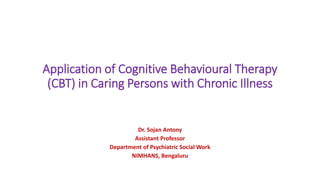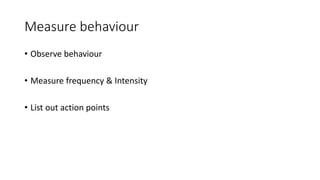Cognitive behaviour therapy in chronic illness
- 1. Application of Cognitive Behavioural Therapy (CBT) in Caring Persons with Chronic Illness Dr. Sojan Antony Assistant Professor Department of Psychiatric Social Work NIMHANS, Bengaluru
- 2. Chronic Illnesses • Bipolar Affective Disorders • Schizophrenia • Diabetes • Cancer • Heart Diseases • Kidney diseases • Liver Problems • Substance use disorders
- 3. Chronic Illnesses: Common Characteristics • Chronic • Recurrence • Less chance for recovery • Life long medical attention • Financial burden
- 4. Chronic Illnesses • Distress • Disability adjusted life years • Impact on functioning • Care givers burden
- 5. Chronic Illnesses • These Diseases Affect • Thinking • Feeling • Behaviour
- 6. CBT (Cognitive Behavioural Therapy) • Modifying thinking • Enabling to handle emotions • Enhances desirable behaviour
- 7. CBT • Evidence based practice • Problem specific • Time-bound • Change can be measured
- 8. Negative Thoughts • “ I am a burden” • “My life is over” • “I will not disclose others about my problem” • “I am the reason for my problem” • “I will not change my habits” • “My family members are not supportive” • “I am not sure about the treatment and the progress”
- 9. Negative Emotions • Frustration • Anger • Helplessness • Hopelessness • Worthlessness • Fear • Emptiness
- 10. Undesirable Behaviours • Poor adherence to treatment • Unhealthy Life style • Substance abuse • Withdrawal from social interaction • Aggression • Suicide attempts
- 11. CBT Process • Listing negative thoughts, emotions, & behaviours • Understanding ABC- Antecedents, Behaviours & Consequence • Helping them to learn Relaxation strategies
- 12. Handling negative thoughts • Developing insights • Recognize thoughts • Exploring alternative thoughts • Nurturing healthy thoughts
- 13. Measure behaviour • Observe behaviour • Measure frequency & Intensity • List out action points
- 14. Relaxation strategies • Muscle relaxation techniques • Mindfulness • Guided imagery • Physical Activity
- 15. Use Reinforcement • Positive Reinforcement • Negative Reinforcement
- 16. Other BT techniques • Desensitization • Flooding • Front Chaining • Back Chaining
- 17. Some principles • Measure • Micro targets • Focus on micro gains • Use of reinforcements • Sensitive to life cycle stages
- 18. Some principles • Directive • Realistic goals • Have supervision • Recording
- 19. Conclusion • CBT is an effective therapy to mitigate the psychosocial impact of chronic illness on Individual.
- 20. Thank you



















